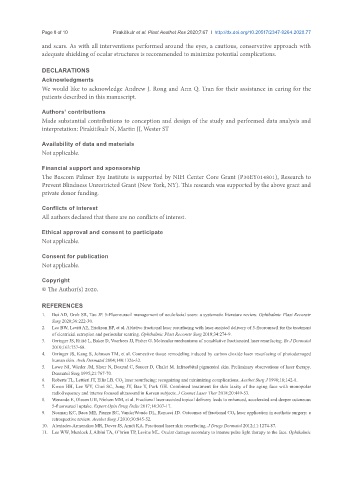Page 794 - Read Online
P. 794
Page 8 of 10 Pirakitikulr et al. Plast Aesthet Res 2020;7:67 I http://dx.doi.org/10.20517/2347-9264.2020.77
and scars. As with all interventions performed around the eyes, a cautious, conservative approach with
adequate shielding of ocular structures is recommended to minimize potential complications.
DECLARATIONS
Acknowledgments
We would like to acknowledge Andrew J. Rong and Ann Q. Tran for their assistance in caring for the
patients described in this manuscript.
Authors’ contributions
Made substantial contributions to conception and design of the study and performed data analysis and
interpretation: Pirakitikulr N, Martin JJ, Wester ST
Availability of data and materials
Not applicable.
Financial support and sponsorship
The Bascom Palmer Eye Institute is supported by NIH Center Core Grant (P30EY014801), Research to
Prevent Blindness Unrestricted Grant (New York, NY). This research was supported by the above grant and
private donor funding.
Conflicts of interest
All authors declared that there are no conflicts of interest.
Ethical approval and consent to participate
Not applicable.
Consent for publication
Not applicable.
Copyright
© The Author(s) 2020.
REFERENCES
1. Bui AD, Grob SR, Tao JP. 5-Fluorouracil management of oculofacial scars: a systematic literature review. Ophthalmic Plast Reconstr
Surg 2020;36:222-30.
2. Lee BW, Levitt AE, Erickson BP, et al. Ablative fractional laser resurfacing with laser-assisted delivery of 5-fluorouracil for the treatment
of cicatricial ectropion and periocular scarring. Ophthalmic Plast Reconstr Surg 2018;34:274-9.
3. Orringer JS, Rittié L, Baker D, Voorhees JJ, Fisher G. Molecular mechanisms of nonablative fractionated laser resurfacing. Br J Dermatol
2010;163:757-68.
4. Orringer JS, Kang S, Johnson TM, et al. Connective tissue remodeling induced by carbon dioxide laser resurfacing of photodamaged
human skin. Arch Dermatol 2004;140:1326-32.
5. Lowe NJ, Wieder JM, Shorr N, Boxrud C, Saucer D, Chalet M. Infraorbital pigmented skin. Preliminary observations of laser therapy.
Dermatol Surg 1995;21:767-70.
6. Roberts TL, Lettieri JT, Ellis LB. CO 2 laser resurfacing: recognizing and minimizing complications. Aesthet Surg J 1996;16;142-8.
7. Kwon HH, Lee WY, Choi SC, Jung JY, Bae Y, Park GH. Combined treatment for skin laxity of the aging face with monopolar
radiofrequency and intense focused ultrasound in Korean subjects. J Cosmet Laser Ther 2018;20:449-53.
8. Wenande E, Olesen UH, Nielsen MM, et al. Fractional laser-assisted topical delivery leads to enhanced, accelerated and deeper cutaneous
5-fluorouracil uptake. Expert Opin Drug Deliv 2017;14:307-17.
9. Neaman KC, Baca ME, Piazza RC, VanderWoude DL, Renucci JD. Outcomes of fractional CO 2 laser application in aesthetic surgery: a
retrospective review. Aesthet Surg J 2010;30:845-52.
10. Alexiades-Armenakas MR, Dover JS, Arndt KA. Fractional laser skin resurfacing. J Drugs Dermatol 2012;11:1274-87.
11. Lee WW, Murdock J, Albini TA, O’brien TP, Levine ML. Ocular damage secondary to intense pulse light therapy to the face. Ophthalmic

